EARLY
WINTER 2010
It
is ages since I last got round to updating us all on what
has been happening on the wildlife front around the village,
so I’d best put that right.
It
doesn’t seem all that long ago that the conditions being
experienced up and down the country were with us at the end
of last winter, bringing with it some spectacular scenery
around the Cookhams, and much disturbance to our birdlife.
Indeed, summer surveys have confirmed fears that small birds
such as Wrens and Goldcrests suffered greatly
with much reduced populations in the months that followed.
And it wasn’t just small birds that found the going tough;
the adult male of our Marsh Meadow Barn owl family
also succumbed, when his weight dropped to less than half
what it should have been. Let’s hope the female finds
another partner soon. A notable winter visitor which was
still around into April was a fine Merlin which hunted
smaller birds in fields adjacent to Long Lane most of the
winter. A Black Redstart was also found in the same area.
After
such a battering, one might have thought spring migrants
would be slower than normal to occupy our countryside, but
in fact some of the earliest arrival dates for decades were
recorded in the county. Nightingales, Reed
Warblers and Common terns all set new record
dates and Hobbies were keen to get back early to us
too. However, I suspect the earliest Hobbies struggled to
find food in the first few weeks as dragonfly numbers were
very low for the second summer running, following a series
of poor breeding seasons
|
|
Our
brand new pool on Marsh Meadow might however provide a good
source of breeding habitat for Dragonflies and Damselflies
and there were Common Blue Damselflies and Common
Darter Dragonflies laying eggs on the fast-maturing
vegetation in the warmer weather. A notable dragon even in
the summer-time was the discovery of a Club-tailed
Dragonfly along the Thames at Marsh Meadow. This is a
scarce species in the county and had not been recorded
anywhere near this far east in the county before, until the
local dragonfly group spotted this one. So for a short
while, we held that record – only for it to be broken when
I came across a female of the species on Thames-side
vegetation all the way down at Home Park Windsor, so this is
a success story for the species which hopefully will be more
regularly seen on our patch and elsewhere.
|
|
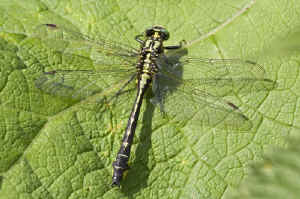
|
|
Club-tail
Dragonfly – Stephen Church |
|
Late
summer brought incredible numbers of Banded Demoiselles
out to breed, with counts of 300+ in various places, so
that’s one species we should see lots of next spring. Our
butterflies had a mixed year. First sightings of the usual
first’s to appear were pretty much on schedule with Brimstones
and Red Admirals seeking early sources of nectar. The
very first Common Blue of the year in the whole UK
was in fact reported from Berkshire. Encouragingly, I saw
more Small Tortoiseshells in the first few days of
spring than through all of last year, but thereafter,
numbers dwindled rapidly, and villagers were disappointed
with numbers on their Buddleias and the previous excellent
numbers of Painted Ladies that fly to us each spring from
the continent did not occur this year.
|
|
2010
was International Year for Biodiversity but it failed to
lift our spirits much as many groups of wildlife recorded
some of the worst declines for some time. Indeed, another
butterfly species, The High Brown Fritillary, joined
the Red List of critically endangered species, joining the
one third of all British butterfly species already on the
list, alongside a fifth of all our dragonflies and a third
of all our bird types. We can only hope action is taken soon
before it gets too late to reverse these trends. Moths
however did bounce back from last year’s poor turn-out,
and although the hoped-for invasion of Silver Y’s that
follow the Painted Lady Butterflies across the
Channel did not occur, there were lots of other
beautifully-marked nocturnal insects visiting gardens and
wood around 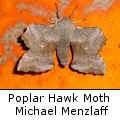 the
village. And they all have wonderful names, so it is a pity
they are not appreciated by more observers. Buff Ermine,
Light Arches, White Plume, Small Emerald, Ruby Tiger,
Beautiful Hooktip and Tawny Marbled Minor are
just some of the names amongst the 2000 or so varieties
there to be found. And whilst anyone would be impressed with
the huge Poplar Hawk Moth or Old Ladies I
found from time to time, it was probably the smallest
species I ever saw that appealed to me most. the
village. And they all have wonderful names, so it is a pity
they are not appreciated by more observers. Buff Ermine,
Light Arches, White Plume, Small Emerald, Ruby Tiger,
Beautiful Hooktip and Tawny Marbled Minor are
just some of the names amongst the 2000 or so varieties
there to be found. And whilst anyone would be impressed with
the huge Poplar Hawk Moth or Old Ladies I
found from time to time, it was probably the smallest
species I ever saw that appealed to me most.
|
| Just
12mm long, and initially defying identification, I
eventually found an expert source of help who pointed out it
was Esperia sulphurella
which hardly ever opens its wings to reveal its amazing
pattern, so my poor quality picture of it in just this pose
was the first he had seen too. |
|
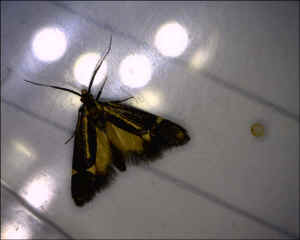
|
|
Esperia
sulphurella
– Brian Clews
|
|
Later I found a Toadflax
Brocade which is another scarce species in the county.
Their caterpillars feed on those dainty pale-yellow flowers
that abounded in our paddocks and waysides late in the
summer. By the way, it is sometimes the caterpillars that
claim the beauty stakes rather than the final flying form of
the creature, and this was exemplified by a stunning
caterpillar I found early in the year. (see picture below).
I’m
sure you will agree it is a striking beast. So, keen to find
out what it would transform into, I kept a small number in a
tank with foodstuffs and eventually the moths emerged – to
reveal the dullest, most unimpressive insects one could
imagine. They were Dingy Flat-body Moths; and
un-inspiring name for an un-inspiring moth, but that
caterpillar? Wow!
|
|
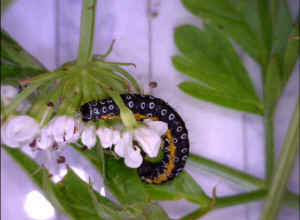 |
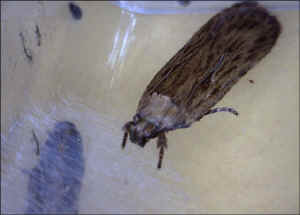
|
|
Dingy
Flat-Body caterpillar – Brian Clews |
Dingy
Flat-Body moth – Brian Clews |
|
It also turned out to be a
good year for another of our local moth rarities. Last year
a number of plants of Dark Mullein were discovered, and this
is the sole food-plant for the larva of the rare Striped
Lychnis Moth. So this year, farmer Copas kept a close
eye out for the plant emerging and as soon as I heard he had
spotted some, I wandered around trying to find other
patches. A large patch alongside on the railway embankment
last year did not sprout up, perhaps due to engineering
works subsequently, but other patches appeared along the
Lea, near Widbrook, in paddocks in Allyns Lane and a few
other spots. Soon caterpillars appeared, and the first task
was to distinguish those of the Mullein Moth from the
Lychnis, as they are nearly identical. But, luck was with us
and amongst 7 colonies of ‘pillars, no fewer than 38
Lychnis larvae were discovered. If they all succeeded in
pupating and survive the winter, that will be a good number
of insects to boost the population next year.
|
|
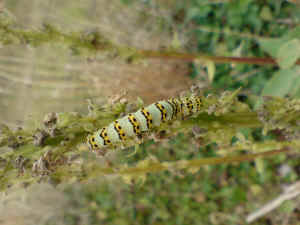
|
|
Striped
Lychnis on Dark Mullein – Brian Clews |
Eventually, all our birds
were in for the year, and it was pleasing to know how many
villagers were hearing Cuckoo for quite some weeks,
as in recent years they seem to just pass through our lovely
village to other summer quarters. I kept a close eye open
for any evidence of a matching female and listened for her
bubbling call throughout the summer, but although the male
paraded all the suitable reedy habitats looking for Reed
Warbler and Sedge Warbler nests, I never got any proof of
breeding here. I did however find 2 Reed Warbler nests with
juvenile Cuckoos in along the nearby Jubilee River. There
were good numbers of Whitethroats, Chiffchaffs and Blackcaps
around the golf course and hedges in the Dean, and I think
the Yellowhammers managed to raise young along Strand Water.
Red Kites and Buzzards all produced young, and
no fewer than 4 pairs of Kestrel nested, tho only 3 seemed
to have produced young; which is good for a species which is
amongst those in decline. Geoff Cubley found himself
observing early fledged young from one of the nests, near
the Alleyns Lane allotments. Probably 2 pairs of Sparrowhawk
also nested, and John Lloyd- Parry got some fabulous shots of
the young on one of the nests.
|
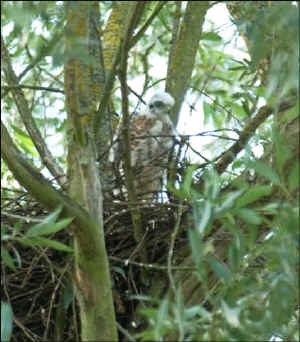
|
|
Sparrowhawk
nest – John Lloyd-Parry |
|
Pam Knight had to suffer Jackdaws
nesting in the chimney whilst Richard James spotted House
Martins nesting at Holy Trinity School, one of only two
sites for this species in the village as far as I know this
year (the other being Odney Club). But the Sand Martins
again used pipe outlets in Thames-side brickwork alongside
The Ferry.
|
|
From personal observation, I
have been worried about falling numbers of Little Owls
in the village. Some many years back, after storms removed
most of the older trees with suitable nest cavities, numbers
fell from some 12 territories to about 5 and we quickly
responded by installing lots of nest boxes. This brought
pairs back up to earlier numbers quite quickly. But now we
are seeing the same small numbers once more, and a survey
identified that many of these old boxes were either damaged,
missing or taken over by Squirrels. It was time for action
and through the kind offices of County Ornithological
Services, funds were made available for a batch of new ones
and these have been installed this autumn, with the help of
Scarlet Arbor whose owner, Ken Scarlet, supplied ladders,
materials (and bravery) to put them all up for us. In
addition, and whilst in the same frame of mind, we
considered our resident Barn Owls and decided to help
them too. This time it was The Kings Hall Trust who stepped
up and most kindly funded the provision of 5 upper-class
accommodation blocks for these regal birds, and these too
were installed in recent weeks. The picture shows Keith and
Linda Hall from Specialised Nestboxes installing the first
aided by Martin Finch and myself. I doubt, to be honest,
there will be sufficient food resources for more than 2
pairs around the village, though this can improve with more
areas of rank vegetation to encourage voles etc, but now,
with sufficient boxes for both females plus chicks, and the
males (who is not allowed in the natal cavity), our two
known territories can hopefully produce the maximum number
of young each season into the future.
|
|
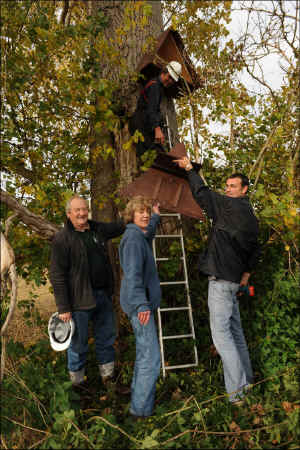
|
|
Nest
Box installation – Advertiser. Shows (l to r) Brian Clews,
Linda Hall, Husband Keith up ladder, and Martin Finch |
The bird season was not done
however: there had been an increasing number of sightings of
Raven around the village in recent years and this
peaked to almost weekly accounts in early spring, usually of
2 together. Then, from late April, only a single bird became
obvious. Could the other be a female on a nest somewhere?
This seemed too much to hope for as Ravens last bred in the
county some 150 or more years ago, and the vast majority of
more recent records came from much more suitable habitat in
the hilly, down-land areas of West Berks. But then the news
came through that a nest had indeed been located in nearby
Maidenhead, and 2 young were raised which are regularly
being led onto Cookham fields to feed with their parents. A
surreal scene a few weeks ago was of the 2 adults sat on top
of a deer carcass down Strand Lane; I thought I was in
Scotland for a minute!
And even that is not the end of the story. Yet
another nest was found this summer, in Windsor Great Park.
The significance of this is that it was the Great Park that
held the last Berkshire known nest record – in 1848! Which
not only confirms what dogged birds Ravens are, but that
they obviously have fabulous memories!
|
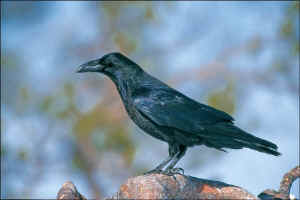
|
|
Raven
– by Gordon Langsbury |
|
Soon, the usual
‘disappearance of our ‘local birds occurred, as reported by
David and Audrey Finch for example. This happens in September in
particular when feeders, used regularly up until then, seemed
abandoned, and folk get concerned that something has gone wrong.
Normally however, this is simply a time of plenty in the
country-side and adult birds lead their progeny off there to teach
them to forage for themselves, removing any dependency upon
artificial feeding. But it usually not long before they return,
and with harsher weather imminent, it is important to stock up!
So, we now approach another
winter, and it got its cold talons out for us even before November
kissed goodbye to 2010. The big news of the moment is that huge
numbers of Waxwings began appearing in Scotland by the end of
October, with an invasion of several thousand birds involved. This
is an irruptive species only coming to UK in significant numbers
every few years. And it looks like 2010 is going to be one of
those years. By early November good sized flocks were appearing
all down the east coast, and at several inland locations down to
about the West Midlands. But this week, small numbers, probably
pioneers, have appeared in both Bucks and Berks (in Bracknell), so
hopefully it is just a question of time before we get some more
local ones. Do keep your eyes open, especially if you have
berry-bearing bushes or hedges in your garden.
Also, as I say, be sure to put out food for the birds throughout this
cold snap, and think twice before turning over any compost heaps
and such-like as there may well be hibernating Hedgehogs
within. If possible, leave such tasks until early spring. And if
you do find a spiky friend wandering around this winter, think
about taking it to Tiggywinkles in Aylesbury, but ring them
beforehand as they may advise weighing it first; a
healthy-weighted hog out in a mild break to the weather might be
quite natural behaviour. (01844 292292). If you clean your
nest boxes out each year, this might be a good time to do so, and
installing any new ones should ideally be done before 2011 signs
in.
It’s
been another fascinating year for crawling around seeking out what
amazing creatures share this wonderful part of God’s creation
with us. I do hope you will be encouraged to get your binoculars
dusted off this winter, and your knees dirty next spring. If
anything unusual turns up in the meantime, I’ll endeavour to let
you know.
Seasons
Greetings
Birdman.
|
|
|

 the
village. And they all have wonderful names, so it is a pity
they are not appreciated by more observers. Buff Ermine,
Light Arches, White Plume, Small Emerald, Ruby Tiger,
Beautiful Hooktip and Tawny Marbled Minor are
just some of the names amongst the 2000 or so varieties
there to be found. And whilst anyone would be impressed with
the huge Poplar Hawk Moth or Old Ladies I
found from time to time, it was probably the smallest
species I ever saw that appealed to me most.
the
village. And they all have wonderful names, so it is a pity
they are not appreciated by more observers. Buff Ermine,
Light Arches, White Plume, Small Emerald, Ruby Tiger,
Beautiful Hooktip and Tawny Marbled Minor are
just some of the names amongst the 2000 or so varieties
there to be found. And whilst anyone would be impressed with
the huge Poplar Hawk Moth or Old Ladies I
found from time to time, it was probably the smallest
species I ever saw that appealed to me most.





